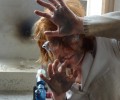If you say “DIY Chemistry”, you immediately conjure up images of children sticking mints into two litre bottles of fizzy pop, setting fire to various plastics in a mini bonfire in a pit they've dug into the pebbling in the back yard, or boiling fragrant petals in an attempt to distil their extracts. It's not that I didn't do all of these things as a child, it's that that isn't surprising. Kids. No matter how much everybody moans about the cotton wool generation, kids still have a natural tendency to put things in their mouths and set them on fire. Just not at the same time.
When I say “DIY Chemistry”, I'm talking about adults. Because despite the safe and broadly available tools for chemistry and other science experiments that exist in the world today, there's something not only cheaper, but more fun and fundamental about making it yourself. And dangerous too – but hence fun.
Most of the lab-based DIY I encounter is elementary. It comes down to using rubber bands to hold pieces of glassware together (including pieces of glassware being heated, and including post-eruption, which might have warned the chemist, but didn't), and using household appliances or beauty products to do the job of industrial equipment. Some of this is just basic, safe hardware. In my current lab, for example, we have a gun cabinet. In it we keep a Black & Decker heat gun, because the specialist lab ones are too expensive. Not to be outdone, a previous lab I worked in used a hairdrier, and kept in the glovebox a pair of hair straighteners, which were used for sealing aluminium packets by melting the seal down.
Various science teachers and science communicators have gone even more freelance. From homemade squealing jelly baby experiments (once banned because jelly babies are symbolic of humans and this imagery might induce children to torture), erupting volcanoes and hydrogen rockets made of plastic tubs, to ingesting helium, using basic salts to set soya milk, or employing hydrogen gas to set your hand on fire. In the end, they seem risky at the time, but it's not a big risk. It's a domestic level hazard and for someone who's seen her mother accidentally boil the metal on the bottom of an empty pan, it doesn't seem that large. But what do you think? To DIY or not to DIY?
